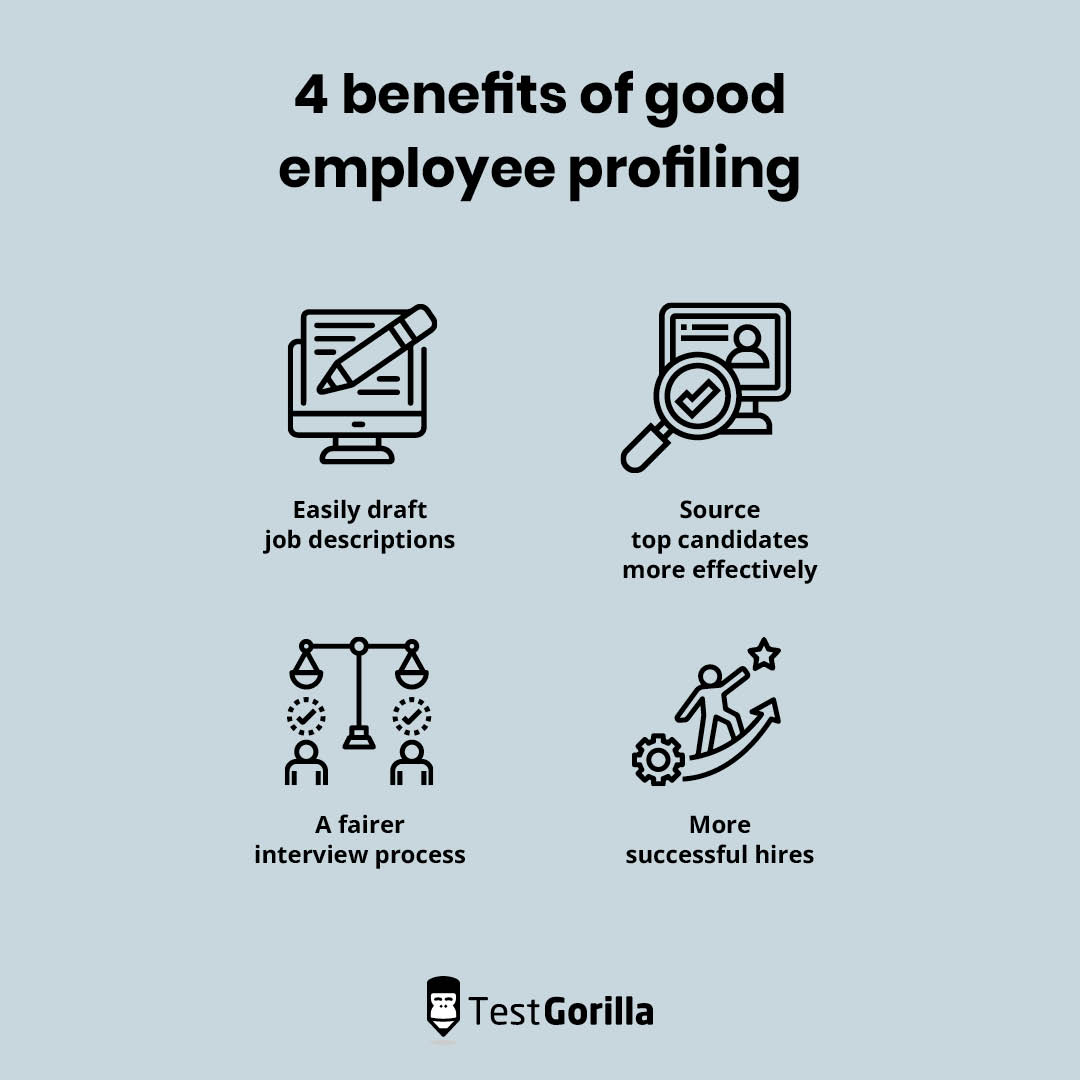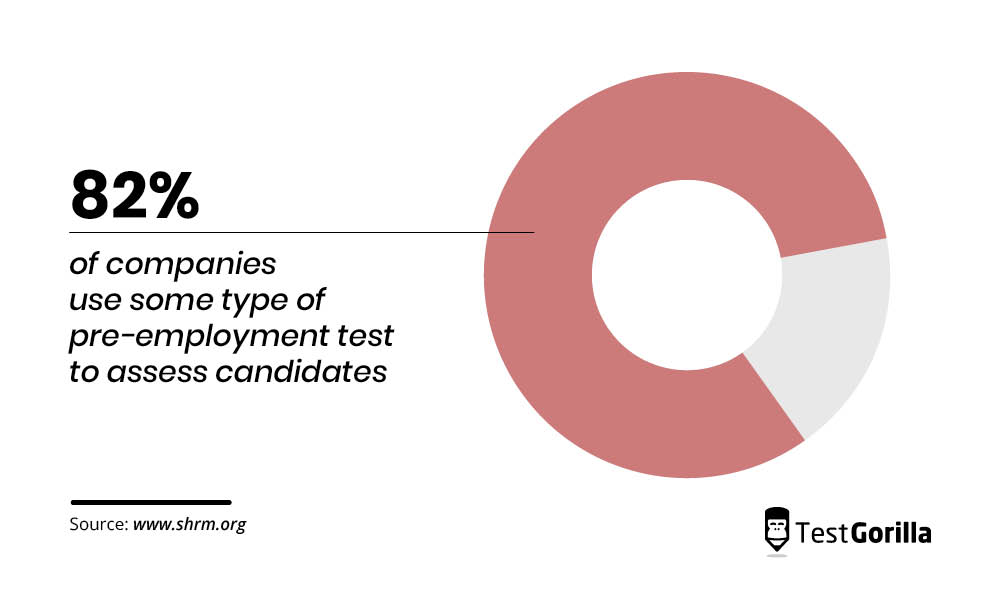Employee profiling: How to create an effective employee profile for hiring
Recent developments in our post-pandemic world have created more opportunities to work remotely and earn professional certifications virtually. As such, it’s crucial to implement an effective employee recruitment style to ascertain candidates’ skills and qualifications.
Adopting a modern recruitment model like employee profiling and reliable pre-employment tests can help you discover the best candidates for the job.
In this article, we explain employee profiling, discuss its benefits and types, and explore the steps to conduct employee profiling. We’ll also discuss how personality tests are integral to creating clear employee profiles.
Table of contents
What is employee profiling?
Employee profiling is the act of collecting critical data about candidates for a job, like how they handle challenges, work in a team, or control their emotions. This in-depth evaluation process helps improve candidate assessment.
Employee profiles enable you to look at individual candidates from a more personal perspective rather than basing your assessment solely on their expertise and education. They’re a vital tool that can help you capitalize on candidates’ potential long-term value and reduce turnover.
4 benefits of good employee profiling
Making detailed employee profiles is beneficial to your company’s pre- and post-employment processes in the following ways:
1. You can draft job descriptions easily
Preparing a job description for a role can be difficult, especially without the help of an effective job description template. Employee profiles help you streamline the level of expertise and qualification you desire for a specific role.
Including the types of soft skills and personality traits you desire in candidates also makes it easier to discover applicants who fit your employee persona.
2. You source top candidates more effectively
Since the next step after preparing a job description is to post it, clear candidate profiles provide insights into the ideal talent-sourcing strategies you should implement. In addition, a well-made profile will enable you to search for candidates on the right platforms.
3. You have a fairer interview process
A credible employee profile enables you to conduct interviews effectively. Although it’s normal for you to take an interest in some candidates instantly, having an employee profile curtails your unconscious bias to help you find the ideal candidate.
4. You have more successful hires
The final result of an adequate job description, candidate sourcing, and a fair interview is hiring an ideal candidate who suits your needs. Placing an employee profile at the foundation of your recruitment process will eventually improve your hiring results.
3 types of employee profiling
Below are three employee profiling tools that can help you assess whether an applicant fits the role’s requirements:
1. Psychometric tests
You can use a psychometric test to profile a candidate’s cognitive abilities and behavioral traits. This test provides insight into whether candidates can be team players and collaborators in their departments.
2. Personality assessments
Personality tests help you determine candidates’ personality traits. An example of a personality assessment is asking candidates questions about their personalities that require them to rate themselves.
3. Social media profiling
Another effective tool for learning more about a candidate is to visit their social media profiles. For example, you can connect with candidates on their LinkedIn and Instagram profiles, provided they are publicly accessible.
5 steps to complete the employee profiling process
In any recruitment process, your results mostly depend on the quality of information you have about your candidates. Use the following employee profiling steps to ensure you hire the best:
1. Assess your company’s key mission and values
Understanding your organization’s values and goals is the first step to conducting an employee profiling process since it helps you determine the type of employees you want. For example, you’ll need friendly employees if your business intends to treat clients intimately.
If your business depends on innovation and being at the forefront of the latest technological developments, you’ll require open-minded, creative, and technically efficient employees.
2. Analyze your present staffing needs
The next step is to identify departments in your company that require more staffing. If you discover open positions that aren’t easy to fill, find out why. The results of your inquiries can help you explore all potential problems you may face when recruiting for specific jobs.
Reviewing your organization’s staffing needs helps you determine whether it would be better to contract or outsource certain roles. You can also outsource the work to an external recruitment agency.
3. Prepare a job description
According to a survey by Indeed, job seekers stated that they spend just three to five minutes reading a job description before deciding whether to apply. This shows the importance of preparing a good job description that accurately describes the role.
A job description is a vital document that lays out the prerequisites for and duties of a given role in an organization. Preparing a job description is an effective method for identifying ideal candidates for open positions.
Including accurate and complete information about the position in your job description will make it much easier for you to attract suitable applicants. You can also provide details on your organization’s vision, culture, and goals and how the role is instrumental to achieving said goals.
For example, if you intend to hire a MongoDB developer, you should include that you’re looking for a coding expert willing to learn new frameworks and coding languages. You could also state that they should be able to work in a team and have the problem-solving skills to find and resolve bugs.
4. Give candidates prescreening tests
Once you post the job description and begin receiving applications, you can give candidates a prescreening test to find out if their profiles match your requirements.
A pre-employment test can evaluate candidates’ abilities more reliably than screening resumes or cover letters. It’s instrumental in ascertaining candidates’ exact skill level, which is a necessary element in an employee profile.
TestGorilla has several categories of pre-employment tests in its test library, such as tests for technical skills, soft skills, cognitive abilities, situational judgment, and candidates’ personality types, all of which are instrumental in making a good hire.
5. Interview successful candidates
After obtaining the test results, you can shortlist candidates with the technical and non-technical skills needed for the role.
Invite a few exceptional applicants for the final stage: interviewing for a position in your business. You can choose to conduct virtual or physical interviews. Virtual interviews are best for remote job openings or if the candidate is far away.
For virtual interviews, ensure you have a reliable internet connection and communication device for seamless interaction with the candidate. You can also prepare interview questions to examine candidates’ personalities, even in virtual conversations.
In-person interviews are essential if you require their physical presence to examine their skills. This type of interview is suitable for permanent in-office positions.
Use TestGorilla for effective employee profiling
Creating a clear employee profile often requires you to use a pre-employment test that accurately examines candidates’ expertise and other non-technical skills. A survey by SHRM shows that 82% of companies use some type of pre-employment test to assess candidates.
Remember that the information in applicants’ resumes or cover letters might not accurately reflect their abilities. To prevent bias and inaccurate data from affecting your hiring decisions, use a credible prescreening test platform like TestGorilla that aligns with your employee profiling process.
The results of our personality tests, such as our 16-type personalities test, can be a great help when creating employee profiles for candidates.
Register for TestGorilla today and enjoy a more effective hiring process for your business.
Related posts
Hire the best candidates with TestGorilla
Create pre-employment assessments in minutes to screen candidates, save time, and hire the best talent.
Latest posts
The best advice in pre-employment testing, in your inbox.
No spam. Unsubscribe at any time.

Hire the best. No bias. No stress.
Our screening tests identify the best candidates and make your hiring decisions faster, easier, and bias-free.
Free resources
This checklist covers key features you should look for when choosing a skills testing platform
This resource will help you develop an onboarding checklist for new hires.
How to assess your candidates' attention to detail.
Learn how to get human resources certified through HRCI or SHRM.
Learn how you can improve the level of talent at your company.
Learn how CapitalT reduced hiring bias with online skills assessments.
Learn how to make the resume process more efficient and more effective.
Improve your hiring strategy with these 7 critical recruitment metrics.
Learn how Sukhi decreased time spent reviewing resumes by 83%!
Hire more efficiently with these hacks that 99% of recruiters aren't using.
Make a business case for diversity and inclusion initiatives with this data.























